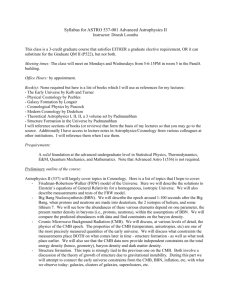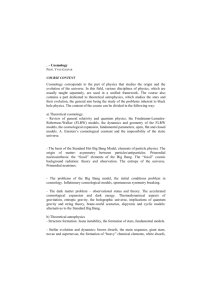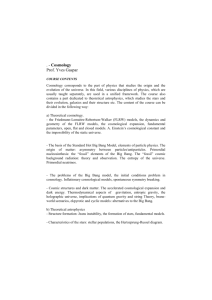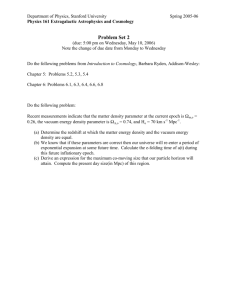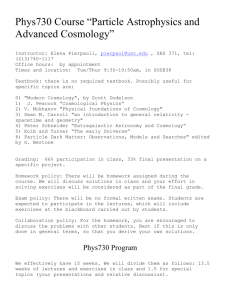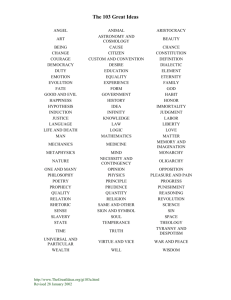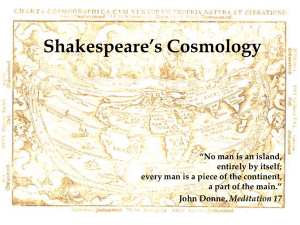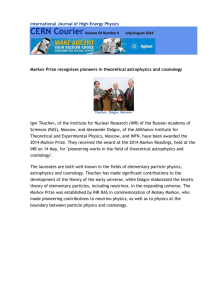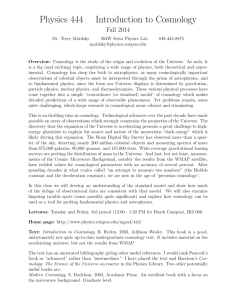CnG_Meeting_Report_March_2005_Contaldi_final
advertisement
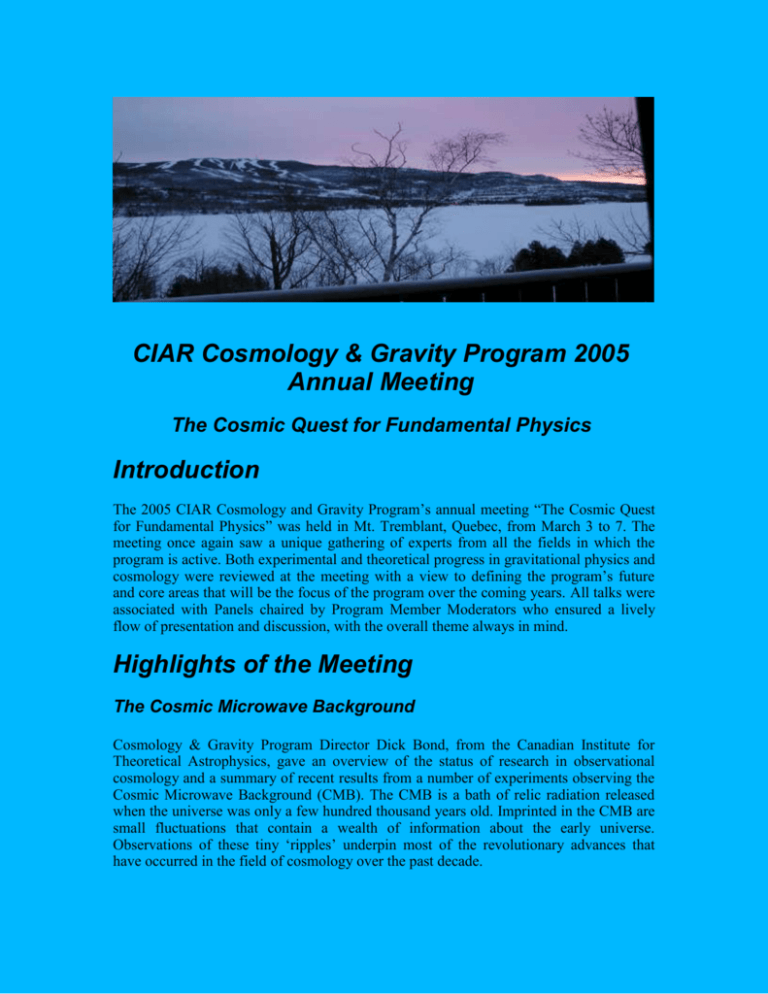
CIAR Cosmology & Gravity Program 2005 Annual Meeting The Cosmic Quest for Fundamental Physics Introduction The 2005 CIAR Cosmology and Gravity Program’s annual meeting “The Cosmic Quest for Fundamental Physics” was held in Mt. Tremblant, Quebec, from March 3 to 7. The meeting once again saw a unique gathering of experts from all the fields in which the program is active. Both experimental and theoretical progress in gravitational physics and cosmology were reviewed at the meeting with a view to defining the program’s future and core areas that will be the focus of the program over the coming years. All talks were associated with Panels chaired by Program Member Moderators who ensured a lively flow of presentation and discussion, with the overall theme always in mind. Highlights of the Meeting The Cosmic Microwave Background Cosmology & Gravity Program Director Dick Bond, from the Canadian Institute for Theoretical Astrophysics, gave an overview of the status of research in observational cosmology and a summary of recent results from a number of experiments observing the Cosmic Microwave Background (CMB). The CMB is a bath of relic radiation released when the universe was only a few hundred thousand years old. Imprinted in the CMB are small fluctuations that contain a wealth of information about the early universe. Observations of these tiny ‘ripples’ underpin most of the revolutionary advances that have occurred in the field of cosmology over the past decade. Suzanne Staggs, a guest speaker from Princeton University, is involved in the planning and building of a number of telescopes for studying the CMB, and she reviewed progress on the development of two of them: the QUIET (Q/U Imaging ExperimenT) and ACT (Atacama Cosmology Telescope) projects. These will both be operating in the Atacama high-plateau desert in Chile and will be collecting some of the highest resolution images of the microwave background by the end of the decade. A fundamental prediction of the standard cosmological model is that photons emitted by the CMB have a specific pattern of polarization on the sky. The detection of this pattern is therefore a crucial step in verifying the current theories of the evolution of the universe. QUIET will be observing the polarization of the CMB photons on unprecedented arcminute scales. (An arcminute is a unit of angular measurement equal to one-sixtieth of a degree.) Staggs also presented recent results from the CAPMAP experiment. This and the CBI (Cosmic Background Imager) and DASI (Degree Angular Scale Interferometer) experiments are the only ones to date with the required level of sensitivity to have detected the polarization of the CMB. (One of the experimental highlights mentioned by Bond in his opening talk and amplified by Program “reporter” Carlo Contaldi was the CMB polarization results from the Cosmic Background Imager telescope and their cosmological implications. The effort to analyze the CBI data is led by researchers at CITA and the results, along with those from CAPMAP, were presented at the CIARsponsored COSMO04 conference held in Toronto in September 2004.) Program member Barth Netterfield, from the University of Toronto, summarized the progress in the analysis of data from the 2002 BOOMERANG flight, the results of which are expected to be published later this year. BOOMERANG is a balloon-borne CMB telescope which is flown from the Antarctic. The 2002 flight also targeted the observation of the polarization of the CMB and will return the most detailed maps of the polarization to date. The BOOMERANG results will complement the existing results from the DASI, CBI and CAPMAP experiments. The BLAST experiment, another balloon-borne telescope observing at infra-red wavelengths, was also reviewed by Netterfield. It will be making its first science flight later in the year and will map the distribution of distant galaxies. Clusters & Galaxy Formation Program members Gil Holder, from McGill University, and Henk Hoekstra, from the University of Victoria, discussed the use of galaxy cluster observations in determining the nature of dark energy. Dark energy is a form of energy whose existence has been postulated to explain why the expansion of the universe appears to be accelerating. It affects the number, size and distribution of clusters of galaxies. In the next few years, a number of surveys will be producing large catalogs of clusters, which will yield constraints on the nature and evolution of the dark energy. However, a careful understanding of the physics involved in the formation and evolution of galaxy clusters must be achieved before these results can be interpreted robustly, and much work is focusing on this problem. Much progress has been achieved in understanding the formation and evolution of galaxies and clusters through huge simulations. A number of speakers presented results 2 from a series of numerical simulations of galaxy formation and growth of structures in the universe. The highlight of the session was the presentation of the latest simulation carried out by the VIRGO consortium, the Millennium computation with over 10 billion particles. This is the largest and most detailed simulation of its kind ever made. A number of Cosmology and Gravity Program members are involved in the VIRGO collaboration, including Julio Navarro from the University of Victoria and Carlos Frenk from the University of Durham and program advisory committee member Simon White from the Max Planck Institute for Astrophysics. More generally, the suite of simulations and their analyses reported at the CIAR meeting represent the most advanced results in the field of numerical cosmology (and numerical relativity). The scales simulated by the cosmological codes range from a few thousand light years to many billions of light years encompassing individual galaxy scales to, for the first time, most of the visible universe. The work in this area is now shifting to ‘mining’ the wealth of information produced by the simulations, a challenging computational problem in itself given the massive quantity of data produced. The main task will be to compare the output of the simulations with various cosmological observables such as the clustering of galaxies, the weak lensing of light rays and to determine general characteristics of clusters of galaxies. This will be crucial for being able to determine cosmological model parameters using future observations of clusters and their distributions. These observations will include direct measurements of the cluster X-ray emissions, the lensing effect surrounding them and their small effect on the CMB. Frenk, Kauffmann, Navarro and White reported on applications as varied as clusters, galaxy formation and evolution, through evidence for tidal debris in our own Milky Way galaxy. Much interaction between researchers at the meeting centred on new applications of the simulation results to a variety of cosmological problems and a number of new collaborations were set up. Alex Szalay, a program member from the John Hopkins University, described his efforts towards the development of a ‘virtual observatory’ where a number of astrophysical observations could be stored for easy access by the whole scientific community. The problem of star formation, from both a theoretical and observational stand point, was discussed by program member Richard Ellis, from Caltech, and guest speakers Guinevere Kauffman, from the Max Planck Institute for Astrophysics, and Norm Murray, from the Canadian Institute for Theoretical Astrophysics. Ellis presented new evidence of significant star formation when the universe was only a few billion years old, which would seem to support a shift in paradigm towards the existence of an early population of first stars. This would also confirm evidence arising from CMB observations that the first stars formed earlier than previously thought. Some models suggest that a population of very massive stars, hundreds of times more massive than the sun, may have arisen at these early times as the first generation of collapsed objects. Particle Astrophysics & High Energy Astrophysics Vicky Kaspi, a Cosmology & Gravity Program member from McGill University, gave an update on her group’s work in interpreting observations of one of the most bizarre and exciting astronomical objects ever seen, the double pulsar system known as PSRJ07370- 3 3039, already discussed at last year’s Cosmology & Gravity annual meeting. The binary system in which both stars happened to be pulsars (i.e. rotating neutron stars with very strong magnetic fields that are misaligned with their axis of rotation) constitutes a unique testing ground for the theory of gravitation due to the incredibly accurate timing of the xray ‘flashes’ released by such pulsars. Guest speaker Norm Murray also reviewed a recent proposal published by Maxim Lyutikov of McGill University and program member Chris Thompson of the Canadian Institute for Theoretical Astrophysics, which explains some intriguing variability in the system’s luminosity. Because the stars are so close together, Lyutikov and Thompson propose that the interaction between their magnetic fields and the plasma surrounding them leads to a complicated pattern of emission, resulting in the variability in the observed luminosity. Their model fits the observations very closely. Program members Lars Bildsten from the Kavli Institute for Theoretical Physics and Andrew Cumming from McGill University also reviewed recent progress in the modeling of neutron stars and their environments. Advisory Committee Chair Art McDonald described the expansion plans for the world’s deepest underground particle physics laboratory in Sudbury, Ontario. Building on the success of the Solar Neutrino Observatory (SNO) at Sudbury, which confirmed the theory of neutrino oscillations (the model whereby different types of neutrinos produced deep inside the sun transform into each other as they travel towards the Earth), the laboratory will be expanded to house more and larger detectors and to host a number of different experiments which require the deep, underground environment. Program member Mark Chen, from Queen’s University, also reviewed some of the future experiments to be planned for the Sudbury site and their possible role in establishing a link between cosmological neutrinos and dark energy. 4 Weak Lensing and Supernovae Surveys A number of program members involved in the Canada-France-Hawaii Telescope Legacy Survey (CFHTLS) reviewed the progress of the observations and their analysis. The survey is mapping a large patch of sky periodically. Its aim is to detect the highest number of distant supernovae to determine the recent expansion history of the universe, and to measure the subtle effect known as weak lensing. Advisory committee member Chris Pritchet, from the University of Victoria, outlined the progress in the supernovae search so far. Almost a hundred supernovae have been detected. Some of the supernovae, known as Type 1a, are considered to be cosmological ‘standard candles’. This means that by measuring their luminosity researchers can calculate quite precisely how far away they occurred. This enables cosmologists to reconstruct the expansion of the universe for the past few billion years. These observations have been the strongest indicator that the expansion has been accelerating, possibly due to an unknown form of dark energy in the universe which could be related to the prediction by Albert Einstein of a cosmological constant, something he considered to have been his famous ‘greatest blunder’. Program members Ludo Van Waerbeke, from the University of British Columbia, and Henk Hoekstra described the progress of the weak lensing observations from the CanadaFrance-Hawaii Telescope (CFHT) Legacy Survey. When completed, this will be the largest weak lensing survey carried out to date. The weak lensing effect is a small distortion of the image of distant galaxies induced by the deflections of light from the galaxies by the intervening matter between the galaxies and the Earth. In principle, the mapping of the lensing provides a unique view of the dark matter in the universe, which cannot be observed directly since it does not interact with visible matter that we are made of. The first measurements of weak lensing were achieved only a few years ago but already this has become one of the most important fields in observational cosmology, at the forefront of which are also involved a number of other CIAR Cosmology & Gravity members such as Richard Ellis and Nick Kaiser of the University of Hawaii. The observations have already yielded significant, independent constraints on cosmological model parameters and it is expected that future measurements will open a unique window onto the evolution of the dark energy form of matter. Kaiser described the proposed PANSTARRS facility, multiple telescopes to be built in Hawaii that would be used to produce the largest mappings of the weak lensing effect covering a large fraction of the sky. The prototype for part of the telescope is complete and undergoing testing and it is expected that ‘first light’ for the prototype will occur in early 2006 with the full telescope being completed by the end of the decade. String Theory and the Early Universe Cosmology & Gravity Program member Lev Kofman, from the Canadian Institute for Theoretical Astrophysics, opened the String Theory and Early Universe session with an 5 overview of the increasing interactions between these two fields. Cosmology has become one of the major testing grounds for fundamental theories, such as that of strings, with many of the most innovative models for inflation – the period of exponential inflation in the first few instants of the universe – now being inspired by a number of models of string theory cosmology. Program member Rob Myers from the Perimeter Institute for Theoretical Physics followed with an overview of the field of string theory. Guest speakers Shamit Kachru and program member Eva Silverstein, both from Stanford University, discussed some of their recent work, including the idea of the string theory ‘landscape’, in which the existence of a cosmological constant is explained through the complexity of the dynamics of string theory. Gary Horowitz, a Program Advisory Committee member based at the University of California at Santa Barbara, described his research into the possible violation of the cosmic censorship by hypothetical objects known as white holes. It is postulated that white holes are formed at space-time singularities in a similar fashion to black holes, but whereas the latter are surrounded by an event horizon and are therefore hidden from view, the former are so-called “naked” singularities that have no such censorship. White holes could occur under special circumstances if the singularities are formed from a collapsing scalar field. These objects would be in direct violation of the well known cosmic censorship hypothesis postulated by Stephen Hawking that states that all singularities lie behind event horizons and that naked singularities cannot exist. Gravitational Waves & Numerical Relativity Guest speaker Scott Hughes, from the MIT, gave an overview of future experiments that will attempt to measure gravitational waves. These waves are predicted by Einstein’s theory of general relativity, but have not been measured yet as they require extremely accurate observations of the displacement of test masses. They are the result of the warping of space-time itself due to the movement of masses, and if measured, would confirm the last unverified aspect of Einstein’s theories. Direct observations of gravity waves are being attempted using very long laser interferometers measuring the distance between two test masses in an experiment known as the LIGO (Laser Interferometer Gravitational wave Observatory). Currently the experiment is slowly reaching the required sensitivity at which it should start detecting the gravitational wave signature of extreme events happening in the universe, such as the final instants of the merger between black holes or a black hole and neutron stars. Program member Matt Choptuik, from the University of British Columbia, and guest speaker David Garfinkle, from Oakland University, gave an update on their continuing efforts at simulating the formation and evolution of singularities that occur when massive stars collapse into black holes. These simulations are also the only method researchers can use to predict the gravity wave emission during mergers to compare with the observations of detectors such as the LIGO facility or the space based LISA mission, which is slated for launch in 2010. Choptuik highlighted the remarkable progress in simulations of colliding relativistic objects made by Frans Pretorius of Caltech, updating the earlier results reported by Frans at the CIAR04 meeting in Banff. (Pretorius is now a Program member.) 6 The meeting also had a highly interactive discussion on the future directions of the Cosmology & Gravity Program and the field in general in view of its next five-year period renewal. It ended with a very lively informal interaction among the string theorists, numerical relativists, high energy and particle astrophysicists and physical cosmologists on the role the interplay between developments in string theory and early Universe physics to the observable world, especially as represented by the many Program initiatives in experimental cosmology. Links to research presented at the meeting Neutrino Observatories: SNO: http://www.sno.phy.queensu.ca/ Galaxy Redshift Surveys: SDSS: http://www.sdss.org/ 2dfGRS link: http://magnum.anu.edu.au/~TDFgg/ CMB experiment links: Ongoing: WMAP: http://map.gsfc.nasa.gov/ ACBAR: http://cosmology.berkeley.edu/group/swlh/acbar/ BOOMERANG: http://cmb.phys.cwru.edu/boomerang/ CBI: http://www.astro.caltech.edu/~tjp/CBI/ DASI: http://astro.uchicago.edu/dasi/ Future: PLANCK: ACT: BICEP: SPT: http://www.rssd.esa.int/index.php?project=PLANCK http://www.hep.upenn.edu/~angelica/act/act.html http://www.astro.caltech.edu/~lgg/bicep_front.htm http://astro.uchicago.edu/spt/ Telescopes: Keck Observatory: CFHT: http://www2.keck.hawaii.edu/geninfo/about.html http://www.cfht.hawaii.edu Participants Fellows Dick Bond (CITA, Physical Cosmology) Mark Chen (Queen’s University, Experimental Particle and Neutrino Astrophysics) Matt Choptuik (UBC, Numerical Relativity) Hugh Couchman (McMaster, Physical Cosmology) Vicky Kaspi (McGill, Observational HEA) Lev Kofman (CITA, Physical Cosmology) Rob Myers (Perimeter Institute, String Theory) 7 Julio Navarro (UVic, Physical Cosmology) Barth Netterfield (UofT, Experimental Cosmology) Ue-Li Pen (CITA, Physical Cosmology) Bill Unruh (UBC, Gravity Theory) Scholars Andrew Cumming (McGIll, HEA) Henk Hoekstra (UBC, Physical and Observational Cosmology) Gil Holder (McGill, Physical Cosmology) Amanda Peet (UofT, String Theory) Ludo van Waerbeke (UBC, Physical Cosmology) Associates Lars Bildsten (KITP, High Energy Astrophysics) Richard Ellis (Caltech, Observational Cosmology) Carlos Frenk (Durham, Physical Cosmology) David Garfinkle (Oakland University, Numerical Relativity) Nick Kaiser (Hawaii, Physical Cosmology) Luis Lehner (Louisiana, Numerical Relativity) Eva Silverstein (Stanford/SLAC, String Theory) Alex Szalay (Johns Hopkins, Physical Cosmology) Reporter Carlo Contaldi (CITA, Cosmology) Advisory Board Members Art McDonald (SNO Institute & Queen's University, Particle Astrophysics, Chair) Gary Horowitz (University of California at Santa Barbara, String Theory, Gravity) Scott Tremaine (Princeton, Astrophysical Dynamics) Chris Pritchet (University of Victoria, Physical and Observational Cosmology) Simon White (Max-Planck-Institut für Astrophysik, Physical Cosmology) Guests Scott Hughes (MIT, Gravity Waves) Shamit Kachru (Stanford University, String Theory) Guinevere Kauffman (Max-Planck-Institut für Astrophysik, Physical Cosmology) Norm Murray (Canadian Institute for Theoretical Astrophysics, HEA & Planets) Suzanne Staggs (Princeton University, Experimental Cosmology) 8 9 10
